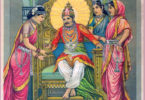Kavita Kane has a flair for viewing epics from a hitherto unexplored character’s point-of-view, a fact that she proved with the immensely popular Karna’s Wife – a narration of Mahabharata from the perspective of Urvi, Karna’s second wife. With Sita’s Sister, she repeats the magic; this time with the Ramayana.
Sita’s Sister is a part fiction, part reality rendition of Ramayana from the perspective of Urmila, Sita’s younger sister, second daughter of King Janaka and Lakshmana’s wife. Urmila is a character that finds little mention in Valmiki’s Ramayana, and the various local versions. However, she is a significant contributor to the events in the story and definitely, one of the strongest characters.
While reading the various traditional renderings of Ramayana, one often wonders why is there so little said about the brave and self-sacrificing wife of Lakshman, who upheld dharma as much as Rama did. If Rama went on an exile to fulfil the promise given by his father to Kaikeyi, citing it to be his dharma to fulfil his father’s wishes, Urmila exiled herself in the palace, so that Lakshman could fulfil his promise of always protecting his brother.
The narrative starts with the childhood of the four sisters – Sita, Urmila, Mandavi and Shrutakirti at the palace of Janaka and Sunaina, king and queen of Mithila. While Sita is the docile one, Mandavi the headstrong one and Shrutakirti the baby, it is Urmila who is portrayed as the anchor of the group, the strong one to whom the others turn for advice, help and solace; literally “the glue that holds them together”.
The story traces their journey from the mentally stimulating and gender impartial environment at the court of Mithila, a place where they interact with learned sages (men and women) and learn to question and argue intelligently; to the patriarchal household at the palace of Ayodhya. Ayodhya is the place where the son obeys the father unquestioningly, the women don’t question their husbands, not even speak up against any injustice; where women are expected to “stay put in their place”. The book explores the sisters’ emotions as they transition from the frank and open assertiveness of Sunaina to the scheming and simmering rivalry between Kausalya and Kaikeyi.
Sita’s Sister is essentially a book that talks about all the women in the Ramayana, unlike Valmiki’s Ramayana that is about Rama, Sita and their exile. And among all these women, it is Urmila who comes out as the most influential character – outspoken yet respectful, headstrong yet calm, strong in the face of adversity, a learned scholar, with an ability to forgive, forget and look at the bigger picture, the tapasvi who has achieved understanding. One cannot help but notice the continued comparison between the unbiased and learning-centric Mithila to the patriarchy ridden Ayodhya.
The book could have done with better editing, containing a number of spelling and punctuation errors and the cover reminds you at first glance of the famed cover of the book Memoirs of a Geisha. Notwithstanding these, the narration is compact, fast-paced and holds your interest to the last word, making Sita’s Sister a must-read for everyone.
Be a good Samaritan: If you liked this review, please share it with others. If you did not, share it with us in the comments below 🙂
We regularly publish original book reviews which you can be read here. Contact us if you are an author/publisher and want us to review your work.
Our affiliates:
If you would like to purchase ‘Sita’s Sister’ by Kavita Kane, you can do so from our affiliates at
Flipkart: Sita’s Sister
Amazon (Paperback): Sita’s Sister
Tell-A-Tale gets a small share of the purchases you make from the affiliate link, helping us bring you the stories you love to read
(This review was first published at Women’s Web)




